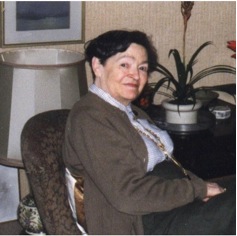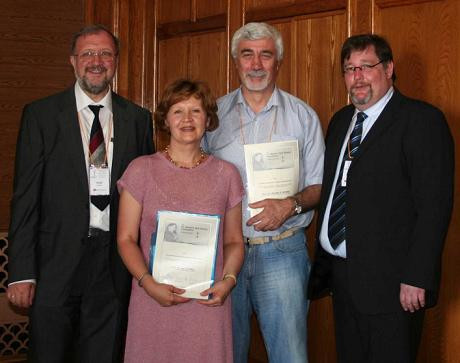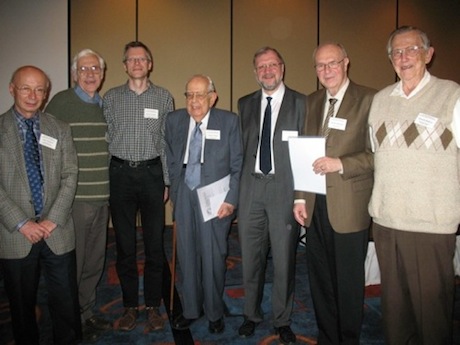International Dr. Barbara Mez-Starck Prize
In memoriam of Barbara Mez-Starck the Dr. Barbara Mez-Starck Foundation (Freiburg, Germany) annually awards a prize for outstanding contributions in the field of experimental structural chemistry and molecular physics including mainly electron diffraction, microwave and high-resolution infrared spectroscopy. The prize consists of one to five thousand Euros. A group of eminent workers in the field are asked for nominations.

Dr. Barbara Mez-Starck dedicated her life to science. She was born in Berlin in 1924 as daughter of Hermann C. Starck who, in 1920, had set up a company dealing in metals, ores, chemicals, greases and oils, which later developed into the famous H. C. Starck company. Barbara Starck opted for an academic career rather than entering her father's company. She became head of the "Section for Spectra and Structure Documentation" (now Section for Chemical Information Systems) at the University of Ulm. In the mid-1970s, she established MOGADOC, a database dealing with gas-phase substances investigated by means of electron diffraction, microwave spectroscopy or molecular radio astronomy. Her father's legacy enabled her to establish the Dr. Barbara Mez-Starck Foundation, the aim of which is to promote research in chemistry and physics.
List of Awardees
| 2016 | Prof. Dr. Michael C. McCarthy, Harvard University, Cambridge, USA, was awarded for his microwave spectroscopic studies of reactive molecular intermediates, especially for his investigations on molecular cations and anions. |
| 2015 | Prof. Dr. Heinz Oberhammer, Eberhard-Karls-University of Tübingen, was awarded for his comprehensive gas-phase electron diffraction studies, especially for his structure determinations of fluorides, peroxides, phosphorus and iminosulfur compounds. Prof. Dr. Lucy M. Ziurys, University of Arizona, Tucson, was awarded for her microwave spectroskopic studies of transition metal compounds in high spin states a well as for her laboratory investigations with interplay with astrophysics, astrochemistry, and astrobiology. |
| 2014 | Prof. Dr. Yunjie Xu, University of Alberta, Edmonton, Canada, was awarded for her investigations of molecular structures of conformers by microwave and high-resolution infrared spectroscopy, especially for the spectroscopic characterization of chiral recognition. |
| 2012 | Prof. Dr. Wolfgang Jäger, University of Alberta, Edmonton, Canada. Prof. Dr. Wolfgang Jäger was awarded for his work on doped hydrogen clusters and small molecules in superfluid helium nanodroplets applying microwave spectroscopy and high-resolution infrared spectroscopy. |

| 2011 | Prof. Lev V. Vilkov, M. V. Lomonosov Moscow State University, Russia. Prof. Vilkov was awarded for his pioneering studies in gas phase electron diffraction and his investigations of structural chemical variations among extended classes of organic compounds. Prof. Georgiy V. Girichev, Ivanovo State University of Chemistry and Technology, Russia. Prof. Girichev was awarded for his structure determinations of inorganic and organometallic compounds by means of combined gas phase electron diffraction and mass spectrometry especially at high temperatures. |

| 2010 | Prof. Dr. James E. Boggs, The University of Texas at Austin, USA
Prof. Boggs was awarded for his molecular structure determinations of conformers, for the best possible combined experimental and theoretical equilibrium potentials of small molecules as well as for the organization of the "Austin Symposium on Molecular Structure" for more than fourty years. Prof. Dr. Harald Møllendal, University of Oslo, Norge. Prof. Møllendal was awarded for his microwave spectroscopic studies augmented by quantum chemical calculations, his molecular structure determinations of conformers, especially for the intramolecular hydrogen bonding and for his contributions to astrochemistry. |
| 2009 | Dr. Jens-Uwe Grabow, Gottfried-Wilhelm-Leibniz-University of Hannover. He was awarded for his outstanding contributions for the improvements of Fourier transform microwave spectrometers as well as for his investigations of molecular structures and nuclear quadrupole and magnetic hyperfine interactions in molecular spectra. |
| 2008 | Dr. Jean Demaison, Universite de Sciences et de Technologies de Lille Flandres Artois, France, was awarded for his outstanding contributions in the determination of accurate equilibrium structures by combining high quality experimental data from high-resolution molecular spectroscopy in the microwave, millimeter wave and infrared region with high level quantum mechanical calculations. |
| 2007 | Prof. Dr. David W. H. Rankin, University of Edinburgh, Edinburgh, Scotland, was awarded for his studies of unusual compounds such as, polyhedral boranes and carbaboranes, sterically crowded silicon compounds, precursors to solid-state materials, aromatic heterocycles and organometallic compounds. |
| 2006 | Prof. Dr. Kozo Kuchitsu, Graduate School of BASE, Tokyo University of Agriculture and Technology, Tokyo, for his contributions to the methodology of structure determination by means of gas electron diffraction and high resolution molecular spectroscopy. |
| 2005 | Prof. Dr. Kenneth Hedberg, Oregon State University, Corvallis (US)A,
was awarded for, among others, the introduction of the least-squares analysis into gas-phase electron diffraction and his contributions to the conformational analysis of organic compounds. He studied very interesting structural effects, such as the planrity of trisilylamine, the pseudolinearity of disilyl ether, the dynamic Jahn-Teller distortion of chromium pentafluoride, and the non-VSEPR geometry of chromyl fluoride. Last but not least, he investigated the gas-phase structures of the fullerenes C60, C70, and C60F48. Prof. Dr. Heinz-Dieter Rudolph, Universität Ulm, was awarded for his contributions in high resolution molecular spectroscopy. In order to improve the accuracy of the experimental molecular structure he studied the microwave spectra of as much isotopic species as possible (up to 41 isotopomers per compound). He was one of the first to build a highly sensitive spectrometer with digital averaging, which allows to measure the microwave spectra of isotopic species in natural abundance. He made several important contributions to the theory of the substitution method, particularly by extending the Kraitchman equations. |
| 2004 | Prof. Dr. Lawrence S. Bartell, University of Michigan, Ann Arbor (USA), for his outstanding contributions to various aspects of gas-phase electron diffraction theory (among others the introduction of vibrational anharmonicity into the structure analysis). |
| 2003 | Prof. Dr. Victor P. Spiridonov, Moscow State University (Russia) for his innovative work in the field of molecular structure determination in terms of potential energy function parameters from electron diffraction. |